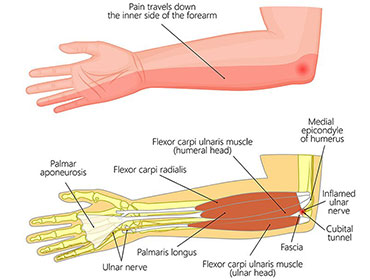Ulnar Nerve Release
The ulnar nerve is one of the three main nerves in the arm that runs from the neck to the little finger, passing through a bony protuberance inside the elbow (medial epicondyle), under the forearm muscles, and down the hand on the side of the palm. The ulnar nerve controls the majority of hand muscles that perform fine motions, as well as certain larger forearm muscles that aid with grip strength.
The ulnar nerve can be compressed in a variety of ways, resulting in nerve entrapment. The nerve compression can produce pain and numbness in different areas of the arm. Cubital tunnel syndrome is a condition in which the nerve is compressed against the medial epicondyle. Ulnar nerve transposition is a surgical operation that moves the ulnar nerve from the rear of the medial epicondyle to a more appropriate place.
Surgical Procedure:
Under general or regional anaesthesia, ulnar nerve transposition is performed.
The ulnar nerve will be located by a tiny incision around the medial epicondyle by your surgeon.
Your surgeon next carefully pulls the ulnar nerve from under the medial epicondyle and puts it in front of it (anterior transposition) (anterior transposition). The nerve can be positioned on top of the muscle, beneath the skin and fat (subcutaneous transposition), beneath the muscle (submuscular transposition), or into the muscle (intramuscular transposition) (intermuscular transposition). After that, the incision will be sutured. When the elbow is bent, the anterior transposition prevents nerve entrapment and stretching at the bony ridge.
After the surgery, your doctor will remove the tourniquet that was applied. Following subcutaneous transposition, the elbow is splinted at a 45-degree angle, and after intermuscular transposition, the elbow is splinted at a 90-degree angle. For a few weeks, the elbow is held in a bent position. Your physical therapist will recommend muscle toning and stretching exercises to help you regain full range of motion, decrease pain, and minimise swelling. After checking with your doctor, you can resume your normal activities.

